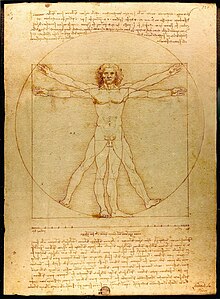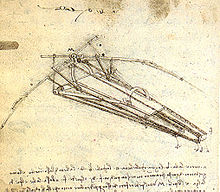Journals and notes
 Renaissance humanism recognized no mutually exclusive polarities between the sciences and the arts, and Leonardo's studies in science and engineering are as impressive and innovative as his artistic work. These studies were recorded in 13,000 pages of notes and drawings, which fuse art and natural philosophy (the forerunner of modern science), made and maintained daily throughout Leonardo's life and travels, as he made continual observations of the world around him.
Renaissance humanism recognized no mutually exclusive polarities between the sciences and the arts, and Leonardo's studies in science and engineering are as impressive and innovative as his artistic work. These studies were recorded in 13,000 pages of notes and drawings, which fuse art and natural philosophy (the forerunner of modern science), made and maintained daily throughout Leonardo's life and travels, as he made continual observations of the world around him.Leonardo's writings are mostly in mirror-image cursive. The reason may have been more a practical expediency than for reasons of secrecy as is often suggested. Since Leonardo wrote with his left hand, it is probable that it was easier for him to write from right to left.
 His notes and drawings display an enormous range of interests and preoccupations, some as mundane as lists of groceries and people who owed him money and some as intriguing as designs for wings and shoes for walking on water. There are compositions for paintings, studies of details and drapery, studies of faces and emotions, of animals, babies, dissections, plant studies, rock formations, whirlpools, war machines, helicopters and architecture.
His notes and drawings display an enormous range of interests and preoccupations, some as mundane as lists of groceries and people who owed him money and some as intriguing as designs for wings and shoes for walking on water. There are compositions for paintings, studies of details and drapery, studies of faces and emotions, of animals, babies, dissections, plant studies, rock formations, whirlpools, war machines, helicopters and architecture.These notebooks—originally loose papers of different types and sizes, distributed by friends after his death—have found their way into major collections such as the Royal Library at Windsor Castle, the Louvre, the Biblioteca Nacional de España, the Victoria and Albert Museum, the Biblioteca Ambrosiana in Milan which holds the twelve-volume Codex Atlanticus, and British Library in London which has put a selection from its notebook BL Arundel MS 263 online. The Codex Leicester is the only major scientific work of Leonardo's in private hands. It is owned by Bill Gates and is displayed once a year in different cities around the world.
Leonardo's notes appear to have been intended for publication because many of the sheets have a form and order that would facilitate this. In many cases a single topic, for example, the heart or the human fetus, is covered in detail in both words and pictures on a single sheet. Why they were not published within Leonardo's lifetime is unknown.
Scientific studies
 Leonardo's approach to science was an observational one: he tried to understand a phenomenon by describing and depicting it in utmost detail and did not emphasize experiments or theoretical explanation. Since he lacked formal education in Latin and mathematics, contemporary scholars mostly ignored Leonardo the scientist, although he did teach himself Latin. In the 1490s he studied mathematics under Luca Pacioli and prepared a series of drawings of regular solids in a skeletal form to be engraved as plates for Pacioli's book De Divina Proportione, published in 1509.
Leonardo's approach to science was an observational one: he tried to understand a phenomenon by describing and depicting it in utmost detail and did not emphasize experiments or theoretical explanation. Since he lacked formal education in Latin and mathematics, contemporary scholars mostly ignored Leonardo the scientist, although he did teach himself Latin. In the 1490s he studied mathematics under Luca Pacioli and prepared a series of drawings of regular solids in a skeletal form to be engraved as plates for Pacioli's book De Divina Proportione, published in 1509.It appears that from the content of his journals he was planning a series of treatises to be published on a variety of subjects. A coherent treatise on anatomy was said to have been observed during a visit by Cardinal Louis 'D' Aragon's secretary in 1517. Aspects of his work on the studies of anatomy, light and the landscape were assembled for publication by his pupil Francesco Melzi and eventually published as Treatise on Painting by Leonardo da Vinci in France and Italy in 1651 and Germany in 1724, with engravings based upon drawings by the Classical painter Nicholas Poussin.[citation needed] According to Arasse, the treatise, which in France went into sixty two editions in fifty years, caused Leonardo to be seen as "the precursor of French academic thought on art".
A recent and exhaustive analysis of Leonardo as scientist by Frtijof Capra argues that Leonardo was a fundamentally different kind of scientist from Galileo, Newton and other scientists who followed him. Leonardo's experimentation followed clear scientific method approaches, and his theorising and hypothesising integrated the arts and particularly painting; these, and Leonardo's unique integrated, holistic views of science make him a forerunner of modern systems theory and complexity schools of thought.
Anatomy
 Leonardo's formal training in the anatomy of the human body began with his apprenticeship to Andrea del Verrocchio, who insisted that all his pupils learn anatomy. As an artist, he quickly became master of topographic anatomy, drawing many studies of muscles, tendons and other visible anatomical features.
Leonardo's formal training in the anatomy of the human body began with his apprenticeship to Andrea del Verrocchio, who insisted that all his pupils learn anatomy. As an artist, he quickly became master of topographic anatomy, drawing many studies of muscles, tendons and other visible anatomical features.As a successful artist, he was given permission to dissect human corpses at the Hospital of Santa Maria Nuova in Florence and later at hospitals in Milan and Rome. From 1510 to 1511 he collaborated in his studies with the doctor Marcantonio della Torre. Leonardo made over 200 pages of drawings and many pages of notes towards a treatise on anatomy. These papers were left to his heir, Francesco Melzi, for publication, a task of overwhelming difficulty because of its scope and Leonardo's idiosyncratic writing. It was left incomplete at the time of Melzi's death more than fifty years later, with only a small amount of the material on anatomy included in Leonardo's Treatise on painting, published in France in 1632. During the time that Melzi was ordering the material into chapters for publication, they were examined by a number of anatomists and artists, including Vasari, Cellini and Albrecht Dürer who made a number of drawings from them.
Leonardo drew many studies of the human skeleton and its parts, as well as muscles and sinews. He studied the mechanical functions of the skeleton and the muscular forces that are applied to it in a manner that prefigured the modern science of biomechanics. He drew the heart and vascular system, the sex organs and other internal organs, making one of the first scientific drawings of a fetus in utero. As an artist, Leonardo closely observed and recorded the effects of age and of human emotion on the physiology, studying in particular the effects of rage. He also drew many figures who had significant facial deformities or signs of illness.
Leonardo also studied and drew the anatomy of many animals, dissecting cows, birds, monkeys, bears, and frogs, and comparing in his drawings their anatomical structure with that of humans. He also made a number of studies of horses.
Engineering and inventions
 During his lifetime Leonardo was valued as an engineer. In a letter to Ludovico il Moro he claimed to be able to create all sorts of machines both for the protection of a city and for siege. When he fled to Venice in 1499 he found employment as an engineer and devised a system of moveable barricades to protect the city from attack. He also had a scheme for diverting the flow of the Arno River, a project on which Niccolò Machiavelli also worked. Leonardo's journals include a vast number of inventions, both practical and impractical. They include musical instruments, hydraulic pumps, reversible crank mechanisms, finned mortar shells, and a steam cannon.
During his lifetime Leonardo was valued as an engineer. In a letter to Ludovico il Moro he claimed to be able to create all sorts of machines both for the protection of a city and for siege. When he fled to Venice in 1499 he found employment as an engineer and devised a system of moveable barricades to protect the city from attack. He also had a scheme for diverting the flow of the Arno River, a project on which Niccolò Machiavelli also worked. Leonardo's journals include a vast number of inventions, both practical and impractical. They include musical instruments, hydraulic pumps, reversible crank mechanisms, finned mortar shells, and a steam cannon.In 1502, Leonardo produced a drawing of a single span 720-foot (220 m) bridge as part of a civil engineering project for Ottoman Sultan Beyazid II of Constantinople. The bridge was intended to span an inlet at the mouth of the Bosporus known as the Golden Horn. Beyazid did not pursue the project because he believed that such a construction was impossible. Leonardo's vision was resurrected in 2001 when a smaller bridge based on his design was constructed in Norway. On May 17, 2006, the Turkish government decided to construct Leonardo's bridge to span the Golden Horn.
For much of his life, Leonardo was fascinated by the phenomenon of flight, producing many studies of the flight of birds, including his c. 1505 Codex on the Flight of Birds, as well as plans for several flying machines, including a light hang glider and a machine resembling a helicopter. The British television station Channel Four commissioned a documentary Leonardo's Dream Machines, for broadcast in 2003. Leonardo's machines were built and tested according to his original designs.Some of those designs proved a success, whilst others fared less well when practically tested.
Reference